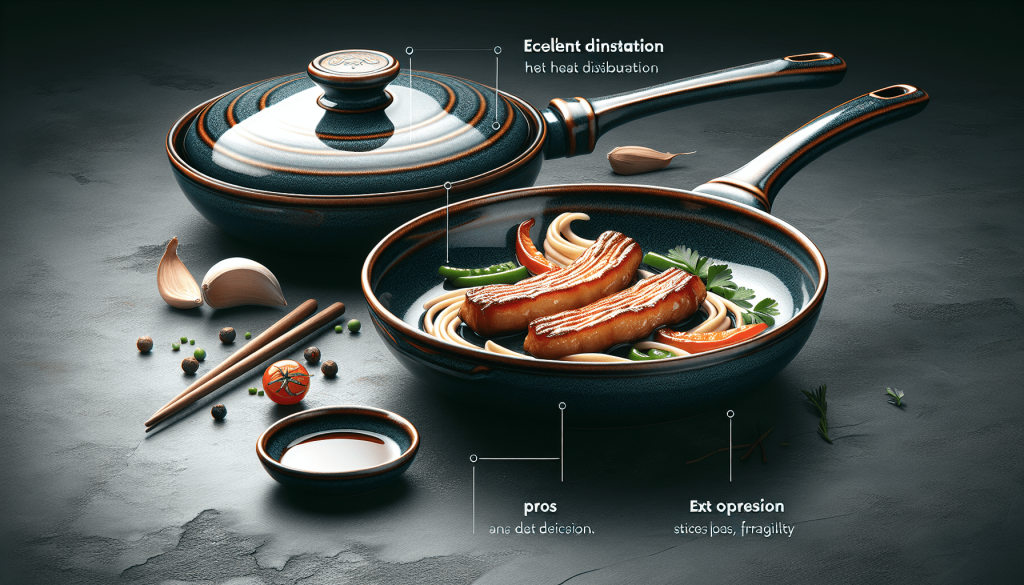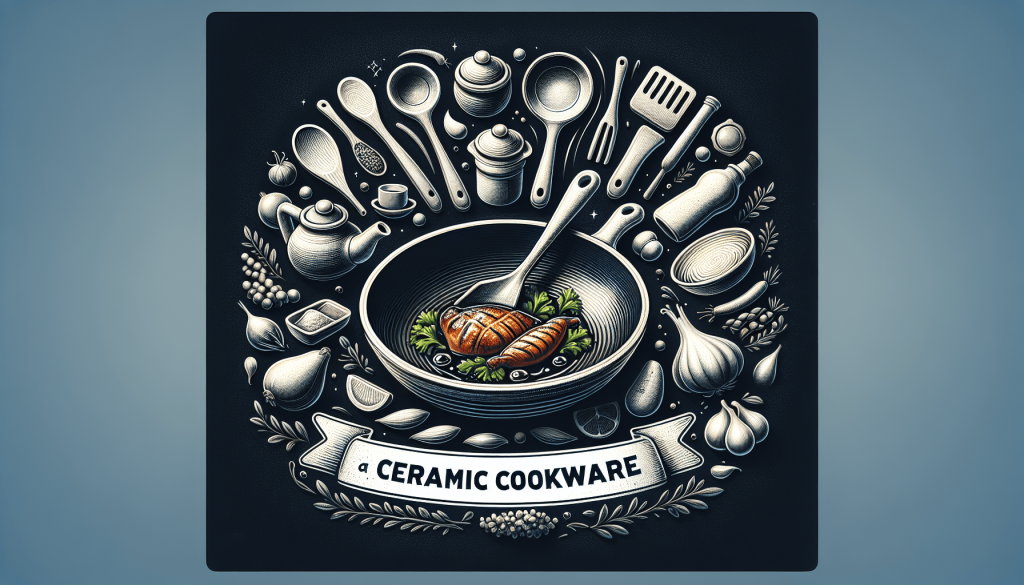Are you constantly on the lookout for the latest and greatest cooking gadgets? If so, then you’ve likely come across the hype surrounding ceramic cookware. It’s become a popular choice among home cooks and chefs alike, but is it really worth all the excitement? In this article, we’ll take a closer look at the pros and cons of ceramic cookware to help you determine if it’s the right option for your kitchen. From its non-stick properties to its potential health benefits, we’ll cover all the essential information you need to know. So, sit back, relax, and let’s dive into the world of ceramic cookware together!

Durability
Long-lasting if properly cared for
Ceramic cookware can be long-lasting and durable if properly cared for. With gentle handling and regular maintenance, it can withstand everyday usage. However, it is important to note that ceramic cookware is prone to chipping and cracking if not handled with care. To ensure its longevity, avoid dropping or banging the cookware against hard surfaces.
Non-stick Surface
Food doesn’t stick easily
One of the biggest advantages of ceramic cookware is its non-stick surface. This means that food does not easily stick to the pan while cooking, making it a breeze to clean up afterwards. The smooth surface allows for easy flipping and stirring of food without it sticking or scorching.
Requires less oil for cooking
Due to its non-stick properties, ceramic cookware requires less oil for cooking. This is great news for health-conscious individuals who are looking to reduce their oil consumption. You can achieve the same delicious results with less oil, resulting in healthier meals for you and your family.
May lose non-stick properties over time
While ceramic cookware offers excellent non-stick properties initially, it is important to note that it may lose its non-stick properties over time. With regular use and cleaning, the ceramic coating can wear off, causing food to start sticking to the surface. To prolong the lifespan of your ceramic cookware’s non-stick properties, it is recommended to avoid using metal utensils and opt for wooden or silicone utensils instead.
Heat Distribution
Evenly distributes heat
Ceramic cookware is known for its excellent heat distribution. Unlike some other cookware materials that can create hot spots, ceramic evenly distributes heat across the entire cooking surface. This allows for more precise cooking and ensures that your food is cooked evenly.
Prevents hot spots
Hot spots can often lead to uneven cooking, where some parts of your food may be overcooked while others remain undercooked. With ceramic cookware, the even heat distribution helps to prevent hot spots from forming. This means that your food will be cooked uniformly, resulting in delicious meals every time.
Takes longer to heat up
It is important to note that ceramic cookware may take slightly longer to heat up compared to other materials, such as stainless steel or cast iron. This is due to its insulating properties, which help to distribute heat evenly but also means that it takes a little longer for the pan to reach the desired temperature. However, once heated, ceramic cookware retains heat well, allowing for even cooking throughout the cooking process.
Versatility
Suitable for various cooking methods
Ceramic cookware is extremely versatile and can be used for various cooking methods. Whether you prefer to sear, sauté, simmer, or even bake, ceramic cookware can handle it all. It is oven-safe at high temperatures, allowing you to easily transition from stovetop to oven without the need for additional cookware.
May not be suitable for induction stoves
While ceramic cookware is compatible with most stovetops, including gas and electric, it may not be suitable for induction stoves. Induction cooking requires a magnetic base, and not all ceramic cookware is designed to meet this requirement. If you have an induction stove, it is important to check the cookware’s specifications to ensure compatibility.

Easy to Clean
Smooth surface makes cleaning easy
One of the major advantages of ceramic cookware is its smooth surface, which makes cleaning a breeze. Food residues and stains are less likely to stick to the surface, allowing for easy removal with a gentle wipe or rinse. This feature is particularly useful when dealing with foods that tend to stick, such as eggs or stir-fry.
Often dishwasher-safe
Many ceramic cookware products are dishwasher-safe, making clean-up even more convenient. Simply place the cookware in the dishwasher after use, and it will come out clean and ready to use again. However, it is always recommended to check the manufacturer’s guidelines to ensure that your specific ceramic cookware is safe to use in the dishwasher.
Stains may develop over time
While ceramic cookware is relatively easy to clean, it is important to note that stains may develop over time, especially if the cookware is subjected to high heat or cooked with highly pigmented ingredients. These stains are generally harmless and do not impact the performance of the cookware, but they can affect its appearance. Regular cleaning and maintenance can help minimize the development of stubborn stains.
Chemical-free Cooking
Does not leach harmful chemicals into food
One of the major benefits of ceramic cookware is that it does not leach harmful chemicals into your food. Unlike some non-stick coatings that may contain potentially hazardous compounds, ceramic cookware is free from harmful substances like PFOAs and PTFEs. This makes it a safe option for health-conscious individuals who prioritize chemical-free cooking.
Safe for health-conscious individuals
With the growing concern over the potential health risks associated with certain cookware materials, ceramic cookware offers a safe alternative. It provides peace of mind to those who strive to maintain a healthy lifestyle and reduce their exposure to potential toxins. By choosing ceramic cookware, you can confidently prepare meals for yourself and your loved ones.
Quality standards vary among brands
While ceramic cookware as a whole is considered safe, it is important to note that quality standards can vary among brands. Some manufacturers may use lower-quality materials or coatings that may not meet the same safety standards. It is crucial to do your research and choose reputable brands that prioritize safety and quality. Look for certifications or labels that indicate that the cookware has undergone rigorous testing and meets industry standards.
Appearance
Sleek and stylish design
Ceramic cookware is known for its sleek and stylish design. It can add a touch of elegance to your kitchen with its smooth and glossy finish. Whether you prefer classic white or vibrant colours, ceramic cookware offers a wide range of options to suit your personal style and kitchen decor.
Available in various vibrant colours
If you’re looking to add a pop of colour to your kitchen, ceramic cookware is the way to go. It is available in a variety of vibrant colours to match your kitchen aesthetics. From bold reds to calming blues, you can find ceramic cookware that complements your kitchen decor and adds a touch of personality to your cooking space.
May lose shine with regular use
Over time, the glossy shine of ceramic cookware may diminish due to regular use. The constant exposure to heat and cleaning agents can cause the surface to lose its initial lustre. While this may affect the appearance of the cookware, it does not impact its functionality. Regular cleaning and proper maintenance can help minimize this effect and keep your ceramic cookware looking its best.
Price Range
Wide range of prices to suit different budgets
Ceramic cookware is available across a wide range of prices, making it suitable for different budgets. Whether you’re looking for an affordable option or willing to invest in a higher-end set, there are ceramic cookware options available to cater to your specific needs and budget.
Higher-end ceramic cookware can be expensive
While ceramic cookware offers a range of affordable options, it is important to note that higher-end ceramic cookware can be quite expensive. With added features, premium materials, and enhanced durability, the price can increase significantly. If you’re looking for top-of-the-line ceramic cookware, be prepared to invest a bit more.
Beware of low-quality options
When it comes to ceramic cookware, it is crucial to be cautious of low-quality options. Some inexpensive ceramic cookware may not deliver the same durability or performance as higher-quality counterparts. It is important to do your research, read reviews, and choose reputable brands to ensure that you’re getting a reliable and long-lasting product.
Weight
Lightweight and easy to handle
Ceramic cookware is known for its lightweight nature, making it easy to handle during cooking. The lighter weight makes it convenient for flipping, stirring, and maneuvering around the kitchen. This feature is particularly beneficial for individuals who may have strength or mobility limitations.
May feel flimsy or less sturdy compared to other cookware
While the lightweight nature of ceramic cookware is advantageous, it can also make the cookware feel flimsy or less sturdy compared to heavier options. Some individuals may prefer the substantial feel of heavier cookware, as it can provide a sense of stability and durability. It is important to consider your personal preferences and cooking style when deciding on the weight of your cookware.
May not distribute heat as evenly as heavier cookware
Due to its lightweight nature, ceramic cookware may not distribute heat as evenly as heavier cookware materials, such as cast iron or stainless steel. The lesser weight can cause slight temperature variations, resulting in uneven cooking. However, with proper preheating and careful attention to cooking times, you can still achieve delicious and well-cooked meals with ceramic cookware.
Maintenance
Requires proper care to avoid damage
To ensure the longevity of your ceramic cookware, it is essential to provide proper care and maintenance. Avoid using metal utensils, as they can cause scratches on the ceramic surface. Instead, opt for wooden or silicone utensils that are gentle on the cookware. Additionally, avoid extreme temperature changes, such as placing a hot pan directly under cold water, as it can lead to thermal shock and potentially damage the cookware.
May need occasional re-seasoning
While ceramic cookware does not require seasoning like cast iron, it may benefit from occasional re-seasoning to maintain its non-stick properties. Applying a thin layer of cooking oil or baking soda paste and allowing it to sit for a short period can help restore the non-stick surface. Regular re-seasoning can also help prolong the lifespan of your ceramic cookware.
Not suitable for rough handling or metal utensils
Ceramic cookware, despite its durability, is not designed to withstand rough handling or the use of metal utensils. Rough handling, such as dropping or banging the cookware, can result in chips or cracks. Metal utensils, such as forks or steel spatulas, can scratch and damage the ceramic surface. To ensure the longevity of your ceramic cookware, handle it with care and use gentle utensils that won’t cause harm.
